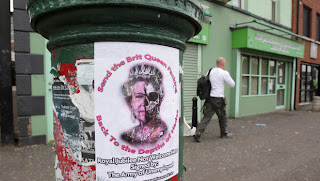Last night, the Protestant Sandy Row district of Belfast staged their annual Orange Order march, leading up to July Twelfth, and I decided to brave it and go see for myself these highly contentious and triumphalist parades.
There were ten Orange Lodges that participated in the event, from around Belfast, and each lodge also has its fife and drum bands which march. Supporters lined the streets in preparation for the march, waving Union Jacks and Protestant Ulster flags, and singing Unionist songs. The police and security forces had to block of the streets around Sandy Row to prevent any clashes that could potentially occur with Irish Catholic nationalists out in opposition to the event, but I was able to get into the area and find a front row position to watch them gather for the parade and then march. I was a little intimidated, and it probably wasn't the smartest place to be-- the working class Protestants of the Sandy Row district are generally a bit edgy about outsiders, and the Ulster Volunteer Force (one of the Loyalist Paramilitaries) is still active in the area. I did get a few dirty looks when I pulled my camera out, and one skin-head looking guy with a bunch of pro-British tattoos did say something to me at one point, but I just moved away up the street from him and didn't have any issues.
Raising up young Ulster Protestants to be just like their Orange Order fathers... I'm not sure that's a good thing.
"King Billy's on the Wall"
There's a famous unionist song associated with the Twelfth that the people of the Sandy Row were singing last night as they prepared for the parade-
"Well there's a famous painting that everybody knows
It stands upon a gable wall over at Sandy Row
In memory of King William and brothers who did join
They fought for our deliverance at the Battle of the Boyne.
In memory of King William and brothers who did join
They fought for our deliverance at the Battle of the Boyne.
King Billy's on the wall
King Billy's on the wall
He stands so high, he shines so bright
He lights up the Falls (referring to the Catholic Falls Road)
There's millions come to see him, they stand and gaze in awe
They remember 1690, King Billy's on the wall."
King Billy's on the wall
He stands so high, he shines so bright
He lights up the Falls (referring to the Catholic Falls Road)
There's millions come to see him, they stand and gaze in awe
They remember 1690, King Billy's on the wall."



















































